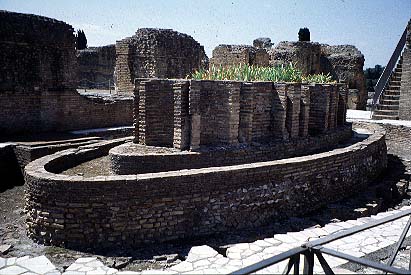
The official dining hall of the palace is nearly as high as it is long, its walls flanked by three stories of different-colored marble columns. Guests could look through wide openings to a fountain court (nymphaeum) on either side whose centerpiece was a tiered oval fountain clad in multicolored marble. No wonder this dining room was reputed to be nicknamed the cenatio Iovis, "Jupiter's banquet hall."
The poet Statius received an invitation to dine in this grand edifice and wrote a fawning poem of thanks (Silvae 4.2) in which he gushes,
mediis videor discumbere in astris cum Iove! . . . Tectum augustum, ingens, non centum insigne columnis, sed quantae superos caelumque Atlante remisso sustentare queant. stupet hoc vicina Tonantis regia, teque pari laetantur sede locatum numina. (10-11; 18-22)
"I seem to be dining in the middle of the stars with Jupiter himself! An august and immense edifice, not distinguished by only 100 columns, but as many columns as could support the sky and the gods if Atlas would relax his charge. The nearby temple of Jupiter the Thunderer is struck with wonder, and the gods are happy that you, Domitian, have been placed in an equal dwelling."